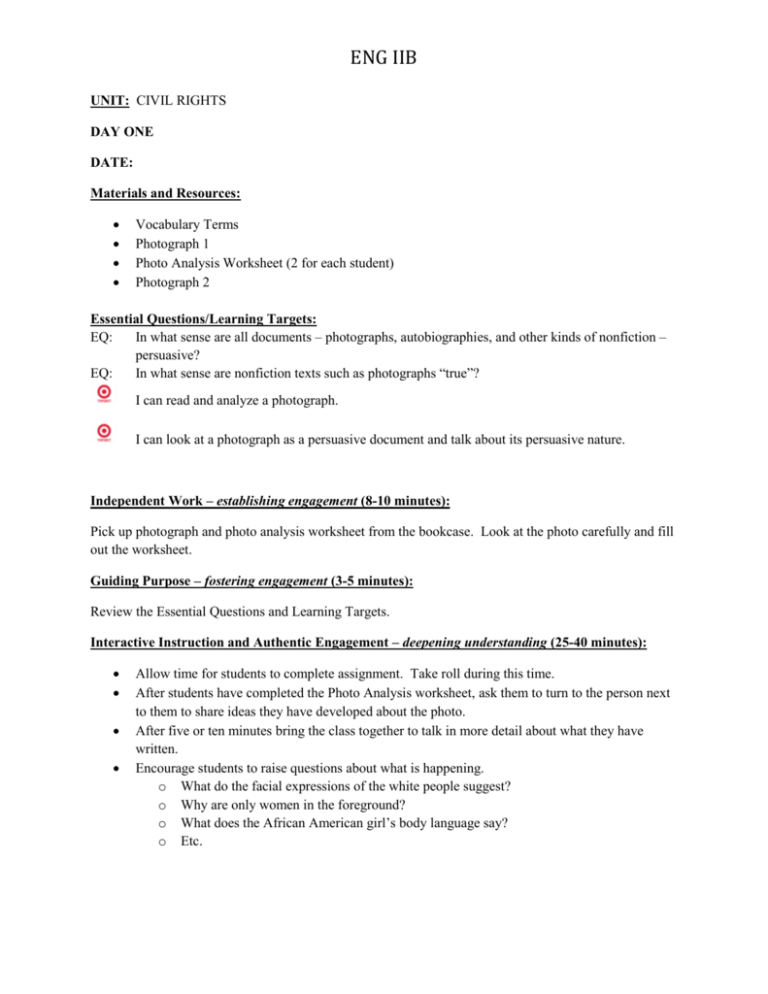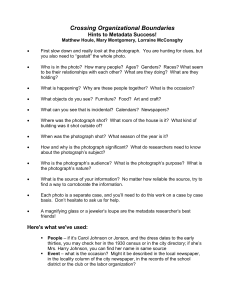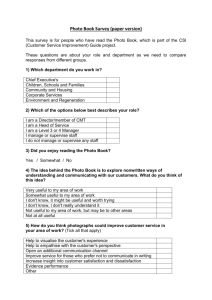DAY ONE - Rowan County Schools
advertisement

ENG IIB UNIT: CIVIL RIGHTS DAY ONE DATE: Materials and Resources: Vocabulary Terms Photograph 1 Photo Analysis Worksheet (2 for each student) Photograph 2 Essential Questions/Learning Targets: EQ: In what sense are all documents – photographs, autobiographies, and other kinds of nonfiction – persuasive? EQ: In what sense are nonfiction texts such as photographs “true”? I can read and analyze a photograph. I can look at a photograph as a persuasive document and talk about its persuasive nature. Independent Work – establishing engagement (8-10 minutes): Pick up photograph and photo analysis worksheet from the bookcase. Look at the photo carefully and fill out the worksheet. Guiding Purpose – fostering engagement (3-5 minutes): Review the Essential Questions and Learning Targets. Interactive Instruction and Authentic Engagement – deepening understanding (25-40 minutes): Allow time for students to complete assignment. Take roll during this time. After students have completed the Photo Analysis worksheet, ask them to turn to the person next to them to share ideas they have developed about the photo. After five or ten minutes bring the class together to talk in more detail about what they have written. Encourage students to raise questions about what is happening. o What do the facial expressions of the white people suggest? o Why are only women in the foreground? o What does the African American girl’s body language say? o Etc. ENG IIB Inform students that the photo they are looking at is one of the most famous images from the civil rights movement and that an important part of the unit will be studying the desegregation of schools after the Brown v. Board of Education Supreme Court decision in 1954. This photograph was taken by Will Counts of Elizabeth Eckford as she tried to enter Little Rock Central High School in Little Rock, Arkansas on September 4, 1957. Ask essential questions. Discuss. Learning to interpret and read photographs and other images is important. It is important to see that, even though a photograph is “real” or “true” it also reflects a particular perspective on events and therefore seeks to persuade viewers to a particular point of view. o What is the point of view being portrayed in this picture? o What does the photographer want you to think? Is he persuasive? Every picture is also a snapshot of a single moment in time; therefore, the story it tells is incomplete. o What do you not know about this picture? o What do you not know about the Civil Rights era? Make a list of questions students have. Encourage students to speculate about how Elizabeth Eckford’s experience might have affected her identity. Have students place photo and analysis worksheet in their notebooks. As a wrap up, show students Photograph 2. This picture is of a sit-in at a Woolworth’s lunch counter in Jackson, Mississippi. Ask students to analyze this photograph by Fred Blackwell in the same way they analyzed the photo of Elizabeth Eckford: o Describe exactly what you see in the photograph. o Summarize what you know about the time and place this photo was taken. o Make inferences about what appears to be happening. o Identify what appears to be missing from the photograph (what’s the rest of the story). As you analyze the photo with the class, help students understand what a sit-in was. In drugstores there used to be counters where people could have a drink or a sandwich; in some parts of the country, these were open only to whites. Just sitting at one of these counters, as the college students are doing in this photo, was dangerous for an African American. Tell students that the African American woman in the photo is Anne Moody, who wrote the book Coming of Age in Mississippi (1968). For homework students should complete a photo analysis worksheet about Photo 2. Closure and Consolidation – making meaning, clarify (5-10 minures): Cover and discuss two vocabulary terms (# _____ &_____).






